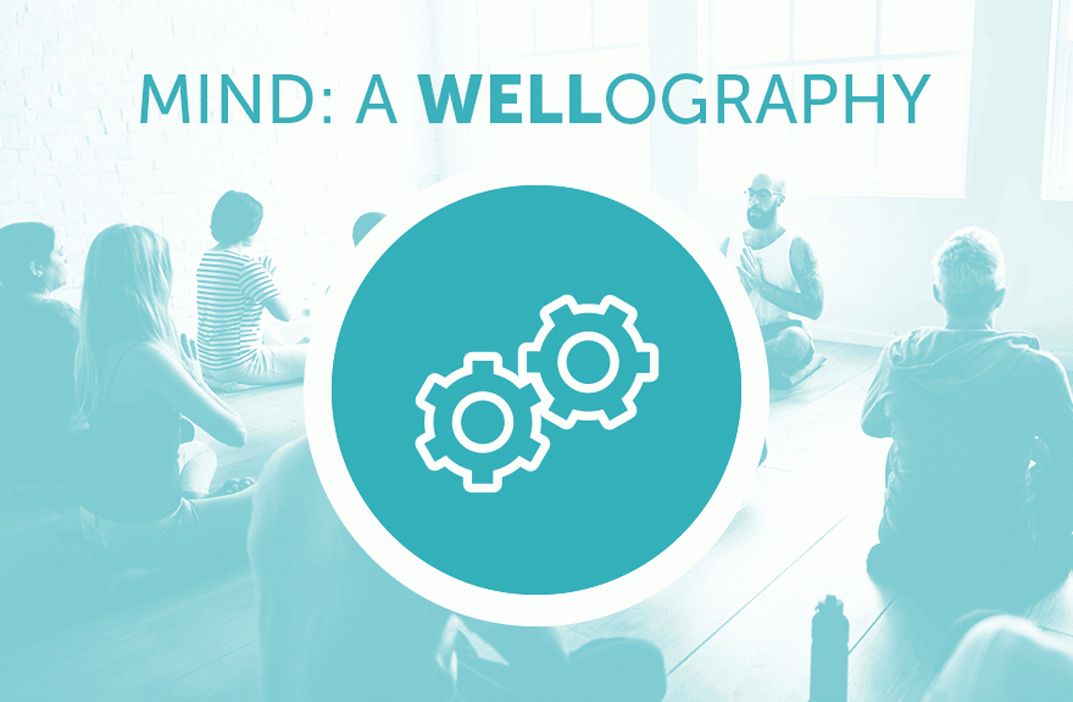Top 5 Takeaways from the Mind #WELLography
by Emily Winer
International WELL Building Institute | Articles
Technology may be advancing every day, but nothing compares to the high-speed power of the human brain. We are a long way from creating a single piece of technology that can control your breath and heartbeat 24/7, keep your body humming along while you are deep in sleep, allow you to simultaneously answer email while watching Netflix, help you stay balanced during yoga class, navigate the NYC subway without ever pulling out a map, and experience the pure joy of a beautiful summer day. That’s an impressive to-do list, not to mention it just barely skims the surface of our brain’s capabilities. Well done, brain.
Ready to wrap your head around the Mind WELLography? Here are our top takeaways:
Did you know the human brain has about 100 billion neurons? These neurons are part of the huge communication network that processes and sends information throughout the body. This network is how you know when that mug of tea is too hot to drink, the volume is too loud in your earbuds, or you need to pull out your sunglasses on a bright day. Want to learn more? The Mind and Human Body section of the WELLography features information and images that map out how it all works.
Learn about the many ways to manage stress at work. Who likes to feel stressed out? Pretty much nobody. Not only does day-to-day stress wreck havoc on your ability to be productive, but it can also cause long-term damage overtime, making you more susceptible to a whole host of health issues, such as the common cold1, poor sleep2,3, weight gain4, and depression5. Check out the Solutions sections of the Mind WELLography to learn about research-based strategies for stress reduction, such as stress management programs and spaces that encourage restoration. And be sure to check out the Fitness WELLography to learn more about the stress-squashing benefits of getting up, out, and moving!
Read up on the power of sleep. Everybody loves a good night’s sleep, but many of us aren’t getting it: data shows that on average, 30% of adults report sleeping less than six hours per night (most adults need 7-8 every night).6 Getting the amount of sleep you need doesn’t just set you up for a productive day (and save you from having to buy that third coffee of the day), but it is also essential for preventing the long-term health risks associated with poor sleep, such as cardiovascular disease,7 poor immune response8, and depression.8 Learn more about how sleep impacts your body in the Health Effects section of the WELLography, and be sure to click on the “Read More” links to explore extended summaries of original research on the effects of sleep on the human body.
How can plants can improve your mental health and wellness? Plants are a powerhouse for human health. Not only are they a critical part of good nutrition (tip: head over to the Nourishment WELLography to learn more), but they are also key in supporting a healthy mind. Access to nature and other natural elements is linked to a range of positive outcomes, such as reduced cognitive fatigue, lowered stress, and improved mood.9-12 Learn more about these benefits and how you can get connected to nature (even in the most urban of places!) throughout the Mind WELLography.
Find out why some spaces make you stressed. Hate being in crowds? Bothered by being packed in like a sardine at the office? Your body and brain don’t like it either! Research has linked crowding in communal spaces with biological and psychological signs of stress, such as discomfort, aggression, and even hormonal imbalance.13 Read more about how crowding and other conditions of your surrounding environment can influence your mental health and well-being in the Elements of Mind section of the WELLography. And get excited for the forthcoming Light, Thermal, and Acoustics WELLographies, which will offer lots of information about how things like the lights, sounds, and temperature in your surrounding environment can impact your mental health and well-being.
Emily supports the Standard Development team at WELL, drawing on her knowledge of the built environment, research, and public health to serve as the Mind subject matter expert. Outside the office, you can find her hiking up in the Hudson Valley and seeking out more ways to incorporate biophilia into her Brooklyn apartment.
Sources:
1 Chronic stress, glucocorticoid receptor resistance, inflammation, and disease risk. Cohen, S. et al. 17 April 2012, Proceedings of the National Academy of Sciences of the United States of America, Vol 106, No 16, pp. 5995-5999. http://doi.org/10.1073/pnas.1118355109
2 Short sleep duration and obesity: the role of emotional stress and sleep disturbances. Vgontzas, AN et al. May 2008, International Journal of Obesity, Vol 32, No 5, pp. 801-9. http://doi.org/10.1038/ijo.2008.4
3 Disentangling the effects of psychological and physical work demands on sleep, recovery and maladaptive chronic stress outcomes within a large sample of Australian nurses. Winwood, PC and Lushington K, December 2006, Journal of Advanced Nursing, Vol 56, No 6, pp. 679-89. https://www.ncbi.nlm.nih.gov/pubmed/17118046
4Stress and adiposity: a meta-analysis of longitudinal studies. Wardie, J et al. April 2011, Obesity, Vol 19, No 4, pp. 771-8. http://doi.org/10.1038/oby.2010.241
5 American Psychological Association. Understanding chronic stress. [Online]. http://www.apa.org/helpcenter/understanding-chronic-stress.aspx
6Centers for Disease Control and Prevention. Insufficient Sleep Is a Public Health Problem. [Online], 3 September 2015. https://www.cdc.gov/features/dssleep/
7Sleep duration and cardiovascular disease: Results from the national health interview survey. Sabanayagam, C and Shankar, A. 8, 2010, Sleep, Vol. 33, pp. 1037-1042. https://www.ncbi.nlm.nih.gov/pubmed/20815184.
8 National Heart, Lung and Blood Institute. Why is sleep important? [Online] February 2012. http://www.nhlbi.nih.gov/health/health-topics/topics/sdd/why
9 The Role of Nature in Coping with Psycho-Physiological Stress: A Literature Review on Restorativeness. Berto, R, December 2014, Behavioral Sciences, Vol 4, No 4, pp. 394-409. http://doi.org/10.3390/bs4040394
10A systematic review of evidence for the added benefits to health of exposure to natural environments. Bowler, DE et al. 4 August 2010, BMC Public Health, Vol 10, No 456. https://www.ncbi.nlm.nih.gov/pubmed/20684754
11 A Review of the Health Benefits of Greenness. James, P. et al. June 2015, Current epidemiology reports, Vol 2, No 2, pp. 131-142. https://www.ncbi.nlm.nih.gov/pubmed/26185745
12People and green spaces: promoting public health and mental well-being through ecotherapy. Buris, A, 2007, Journal of Public Mental Health, Vol 6, No 3, pp. 24-39. http://www.ukmaburbanforum.co.uk/docunents/papers/jpmh-6_3-burls.pdf
13On the distinction between density and crowding: some implications for future research. Stokois, D, May 1972, Psychological Review, Vol 79, No 3, pp. 275-7. https://www.ncbi.nlm.nih.gov/pubmed/5056743





